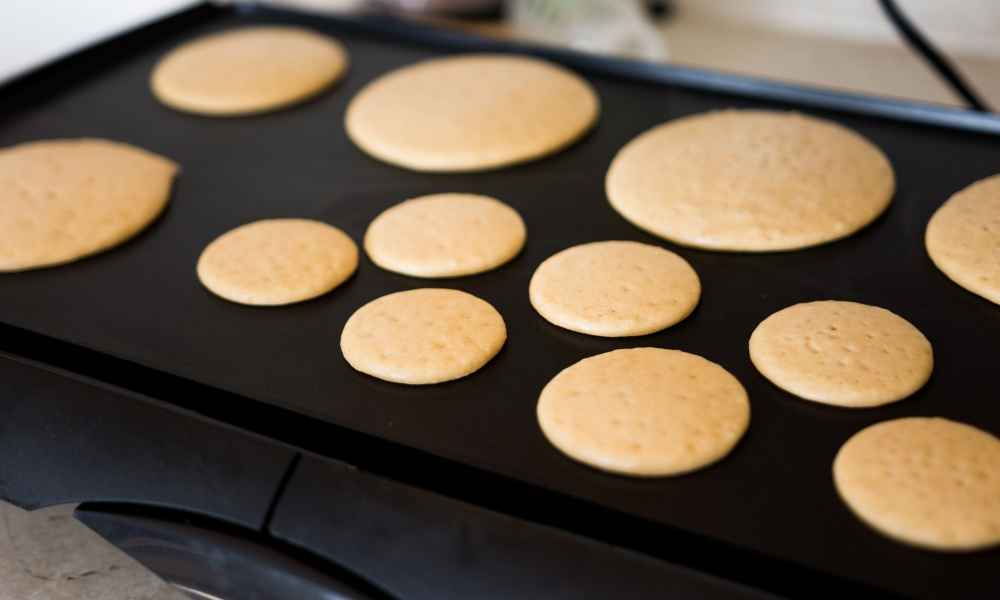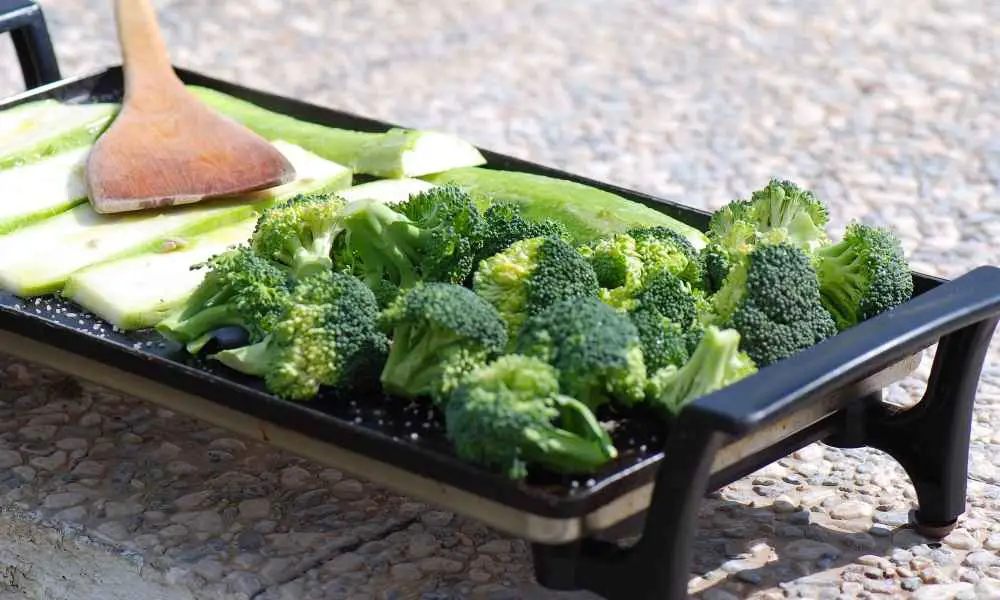If you’re a fan of cooking, you know that a well-seasoned griddle is essential for achieving delicious and evenly cooked meals. Seasoning involves using oil and heat to produce a black, glossy surface that is safe and easy to clean. Grapeseed oil is a versatile oil with a mild taste and is perfect for many cooking tasks, including seasoning your griddle.

According to food science expert Harold McGee, seasoning is simply the act of getting a layer of oil to settle into the nooks and crannies and pores of the metal, and then heating it up. During this process, the fatty acids in the oil react with the metal and the heat, become broken down (oxidized), and reform (polymerize) into larger molecules that create a protective layer on the surface of the griddle. This layer helps prevent food from sticking to the griddle and makes it easier to clean.
Grapeseed oil stands out from other oils due to its high smoke point and neutral flavor, making it an excellent choice for seasoning your griddle. In this article, we’ll guide you through the process of seasoning your griddle with grapeseed oil, step by step. With our tips and tricks, you’ll be able to achieve a perfectly seasoned griddle that will take your cooking to the next level.
Understanding Grapeseed Oil
https://www.youtube.com/watch?v=ToKGZpjWcNE&embed=true
Properties of Grapeseed Oil
Grapeseed oil is a popular oil that is extracted from the seeds of grapes. It is a light, odorless, and flavorless oil that has a high smoke point. This makes it ideal for cooking at high temperatures, such as when seasoning a griddle. Grapeseed oil has a smoke point of around 420°F, which is higher than many other oils commonly used for cooking.
In addition to its high smoke point, grapeseed oil is also high in polyunsaturated fats, particularly omega-6 fatty acids. This makes it a healthy choice for cooking, as these fats are known to help reduce inflammation in the body. Grapeseed oil also contains vitamin E, which is an antioxidant that can help protect the body against free radicals.
Benefits for Griddle Seasoning
When it comes to seasoning a griddle, grapeseed oil is an excellent choice. Its high smoke point means that it can withstand the high temperatures required for seasoning a griddle without breaking down or producing harmful smoke. Additionally, its neutral flavor won’t interfere with the taste of the food you cook on the griddle.
To season a griddle with grapeseed oil, start by applying a thin layer of oil to the surface of the griddle. Use a paper towel to spread the oil evenly over the surface, making sure to cover every inch. Then, turn on the griddle and wait until the surface is dark and smoky. Turn off the griddle and let it cool completely before wiping away any excess oil with a clean paper towel.
Overall, grapeseed oil is a great choice for seasoning a griddle. Its high smoke point and neutral flavor make it ideal for cooking at high temperatures, and its health benefits make it a smart choice for anyone looking to eat healthier.
Preparation Before Seasoning

Before you season your griddle with grapeseed oil, it’s important to prepare the surface properly. This will ensure that the oil adheres to the griddle and creates a smooth, non-stick surface that will last for a long time. Here are the steps you should follow:
Cleaning the Griddle
The first step is to clean the griddle thoroughly. Use a scraper to remove any food debris or grease that may have accumulated on the surface. Then, use a damp cloth or sponge to wipe down the griddle with warm, soapy water. Rinse the griddle with clean water and dry it thoroughly with a clean towel.
Warming the Griddle
Once the griddle is clean and dry, it’s time to warm it up. Turn on the heat to medium-high and let the griddle heat up for about 10 minutes. This will help to open up the pores in the metal and make it easier for the oil to penetrate the surface.
It’s important to note that you should never use soap or abrasive cleaners to clean your griddle after it has been seasoned. This can remove the seasoning and damage the surface of the griddle. Instead, use a scraper and a damp cloth to clean the surface after each use.
By following these simple steps, you can ensure that your griddle is properly prepared for seasoning with grapeseed oil. This will help to create a non-stick surface that will make cooking a breeze and cleaning up a snap.
The Seasoning Process
https://www.youtube.com/watch?v=wlxbH4VJSRI&embed=true
Seasoning your griddle with grapeseed oil is a simple process that can help protect the surface from rust and create a non-stick coating for cooking. Here are the steps to follow:
Applying the Grapeseed Oil
Before applying the oil, make sure your griddle is clean and free of debris. You can use warm soapy water and a soft sponge to clean it. Once it’s dry, apply a thin layer of grapeseed oil to the surface of the griddle. You can use a paper towel or a clean cloth to spread the oil evenly across the surface.
Heating the Griddle
Once the oil is applied, turn on the heat to medium-high and let the griddle heat up for 15-20 minutes. This will allow the oil to penetrate the surface and create a protective layer. You may notice some smoke or a burning smell during this process, but it’s normal and should dissipate after a few minutes.
Cooling and Repeating
After heating, turn off the heat and let the griddle cool down completely. Once it’s cool, use a paper towel to wipe off any excess oil. You can repeat this process several times to create a thicker non-stick coating. Just be sure to let the griddle cool down completely between each application of oil.
In summary, seasoning your griddle with grapeseed oil is a simple process that can help protect the surface and create a non-stick coating. Just remember to clean the griddle before applying the oil, heat it up for 15-20 minutes, and let it cool down completely before wiping off any excess oil.
Post-Seasoning Care

After seasoning your griddle with grapeseed oil, it’s important to take proper care of it to maintain its non-stick surface and prevent rusting. In this section, we’ll discuss how to clean and store your griddle to keep it in top condition.
Cleaning After Seasoning
Cleaning your griddle after each use is essential to prevent food from sticking and to maintain its non-stick surface. Here are some tips for cleaning your griddle:
- Scrape off any food residue: Before cleaning your griddle, use a scraper or spatula to remove any food residue. This will make it easier to clean and prevent food from sticking to the surface.
- Use a soft sponge or cloth: Avoid using abrasive sponges or steel wool as they can damage the non-stick surface. Instead, use a soft sponge or cloth with warm water and dish soap to clean the griddle.
- Avoid soaking the griddle: Do not soak your griddle in water as this can cause rusting. Instead, wipe it down with a damp cloth or sponge.
- Dry the griddle thoroughly: After cleaning, dry the griddle thoroughly with a towel to prevent rusting.
Storing the Griddle
Proper storage is also important to prevent rusting and maintain the non-stick surface of your griddle. Here are some tips for storing your griddle:
- Apply a light coat of oil: After cleaning and drying your griddle, apply a light coat of oil to the surface to prevent rusting. You can use grapeseed oil or any other high smoke point oil.
- Store in a dry place: Store your griddle in a dry place to prevent moisture from causing rusting.
- Cover the griddle: If you’re storing your griddle for an extended period, cover it with a cloth or plastic wrap to prevent dust and debris from accumulating on the surface.
- Avoid stacking other items on top: Do not stack other items on top of your griddle as this can damage the non-stick surface.
By following these tips for cleaning and storing your griddle after seasoning with grapeseed oil, you can ensure that it remains in top condition and provides you with delicious, non-stick meals for years to come.
Troubleshooting Common Issues

If you encounter any issues while seasoning your griddle with grapeseed oil, don’t worry. Here are some common issues and their solutions.
Uneven Seasoning
If your griddle has uneven seasoning, it can cause hot spots and uneven cooking. To fix this, you need to re-season the griddle. Start by cleaning the griddle with a scraper and hot water. Then, dry it completely with a cloth or paper towel.
Next, apply a thin layer of grapeseed oil to the griddle. Use a paper towel to spread the oil evenly across the surface of the griddle. Heat the griddle on high heat until the oil starts to smoke. Let the griddle cool completely before using it.
Oil Not Sticking
If the oil is not sticking to the griddle, it could be because the griddle is not clean. Make sure to clean the griddle thoroughly before seasoning it. If the griddle is clean and the oil is still not sticking, try using a different oil. Grapeseed oil is a good choice for seasoning a griddle, but you can also use other oils like vegetable oil or canola oil.
Excessive Smoke
If you notice excessive smoke while seasoning your griddle, it could be because you are using too much oil. Make sure to apply a thin layer of oil to the griddle. If you are still experiencing excessive smoke, turn down the heat on your griddle. High heat can cause the oil to smoke and burn.
Remember, seasoning your griddle is an important step in maintaining its quality and ensuring even cooking. If you encounter any issues while seasoning your griddle, follow these troubleshooting tips to get back on track.
Frequently Asked Questions

Can avocado oil be used to season a Blackstone griddle?
Yes, avocado oil can be used to season a Blackstone griddle. Avocado oil has a high smoke point and is a healthy option for seasoning your griddle. It is also a good choice for those who are looking for a low cholesterol oil. However, keep in mind that grapeseed oil is the most recommended oil for seasoning a Blackstone griddle.
How often should I season my Blackstone griddle?
It is recommended to season your Blackstone griddle before the first use and then after every use. This will help to maintain the quality of your griddle and prevent it from rusting. If you notice any rust or discoloration on your griddle, it is time to re-season it.
What are the ingredients in Blackstone seasoning oil?
The ingredients in Blackstone seasoning oil are a combination of soybean oil, palm oil, and beeswax. It is specifically designed to help season your griddle and provide a non-stick surface.
What is the best oil to use on a griddle?
Grapeseed oil is considered the best oil to use on a griddle. It has a high smoke point, which means it can withstand high temperatures without burning. This makes it ideal for cooking on a griddle. Other oils that can be used for seasoning a griddle include canola oil, vegetable oil, and avocado oil.
How do I season a griddle?
To season a griddle, first, clean it thoroughly with soap and water. Then, apply a thin layer of oil to the surface of the griddle. Use a paper towel to spread the oil evenly. Heat the griddle on high heat for 15-20 minutes or until the oil starts to smoke. Turn off the heat and let the griddle cool down. Repeat this process 2-3 times before using the griddle.
Can grapeseed oil be used to season a cast iron griddle?
Yes, grapeseed oil can be used to season a cast iron griddle. Grapeseed oil has a high smoke point and is a good choice for seasoning cast iron. However, other oils such as vegetable oil, canola oil, and flaxseed oil can also be used for seasoning cast iron.



